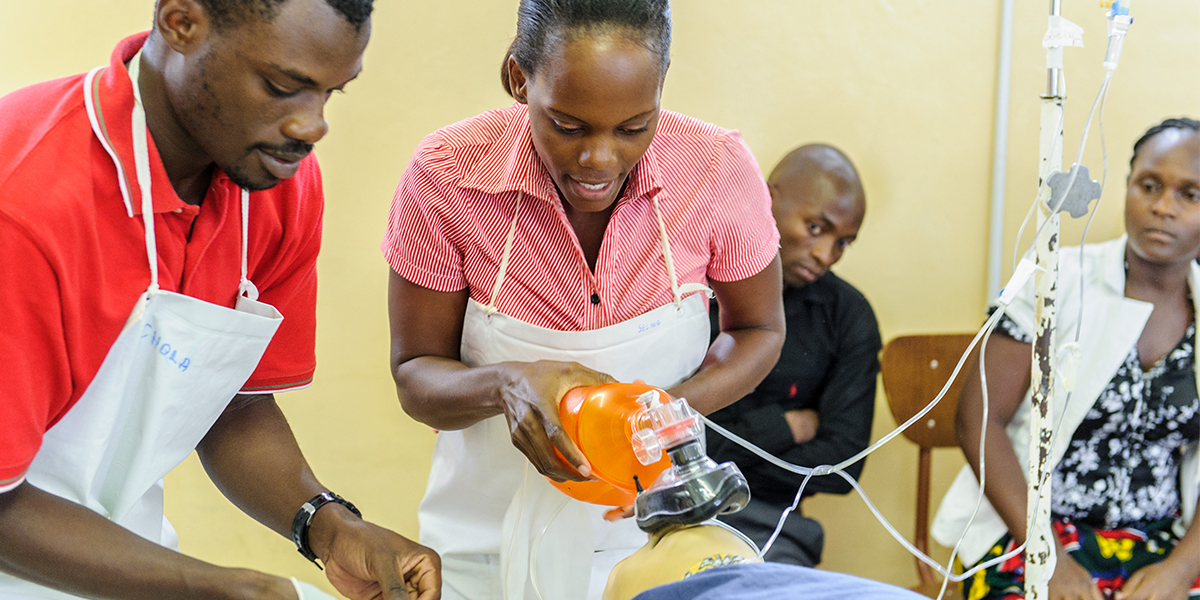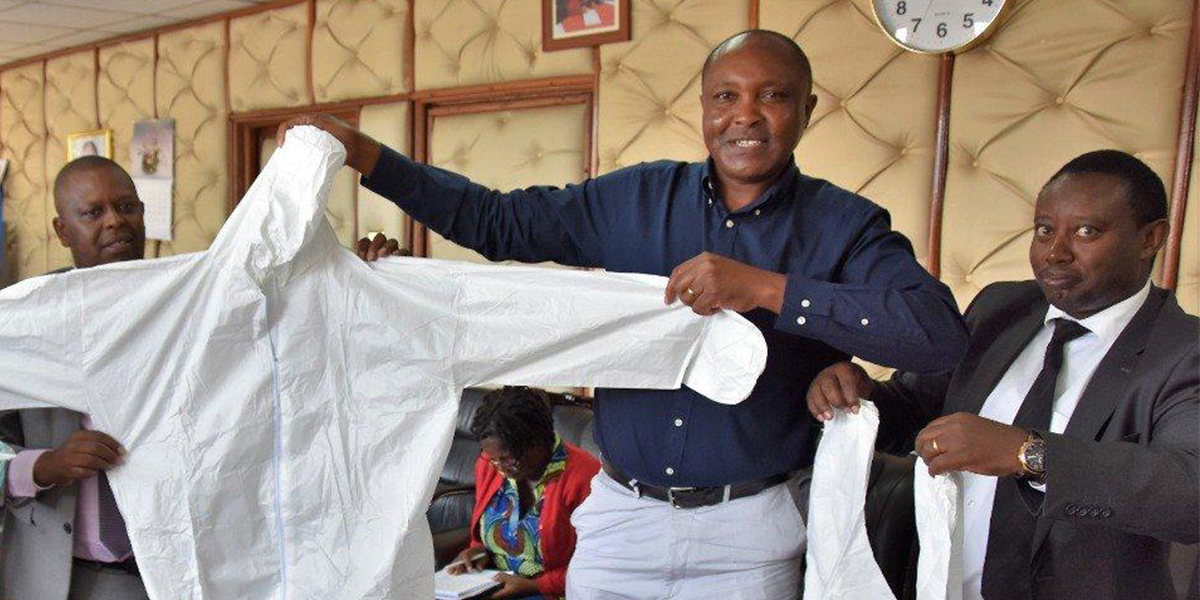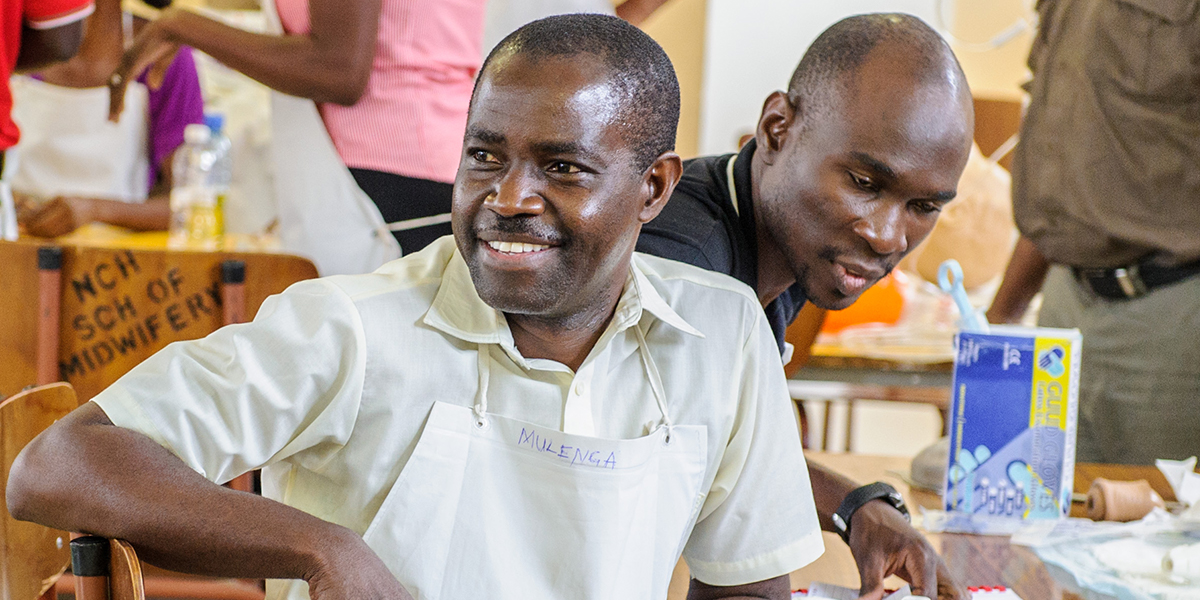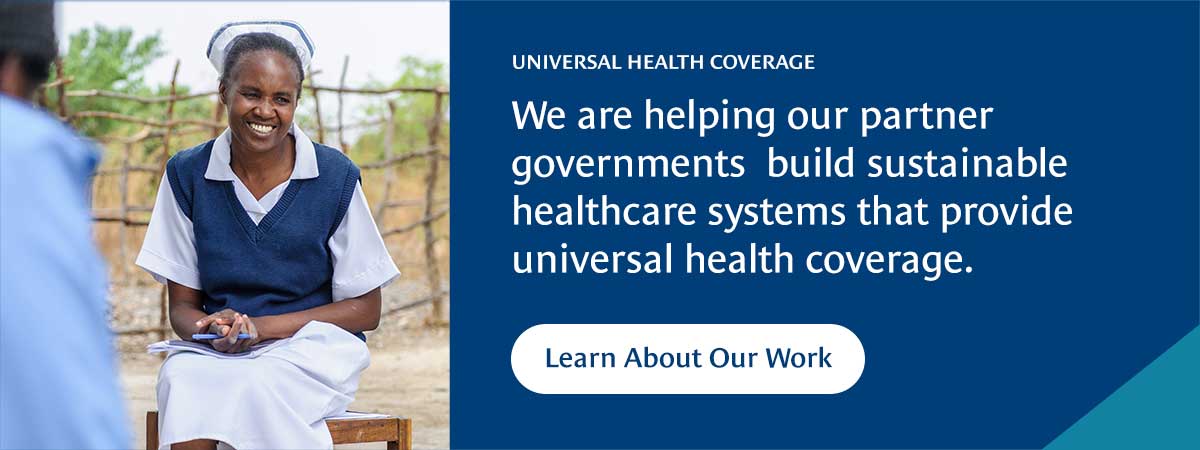Why investing in training and support structures for nurses and other health workers is critical to combating the COVID-19 pandemic and strengthening the health system long-term
For the last 14 months, frontline health workers around the world have shouldered the tremendous burden of treating a global pandemic while continuing to provide essential health services. Nurses, who make up 59 percent of the world’s health workforce, have had to cope with non-stop overtime and are burning out at dramatic rates. Even before the pandemic, burnout rates for nurses in Sub-Saharan Africa were estimated between 51 percent and 87 percent. The situation has been exacerbated by a problem that existed well before the pandemic: a frightening shortage of health workers.
The World Health Organization (WHO) estimates a global shortage of 18 million health workers by 2030, mostly in low- and lower-middle-income countries, with nurses making up about half of this gap. The impact of this on individual health workers, as well as the health systems where they work, is often amplified by poor working conditions, limited remuneration and incentives, as well as inefficient geographical distribution of the available workers.
While continuing to provide essential services during the pandemic, such as testing and treatment for HIV and counseling for family planning and other sexual and reproductive health services, health workers have also been at a heightened risk of infection from COVID-19. According to the WHO estimates in September 2020, health workers accounted for approximately 14 percent of all COVID-19 cases globally, and up to 35 percent in some places, despite making up less than 3 percent of the population in most countries. In many countries, nurses had the highest rates of COVID-19 infection of all health worker groups, such as in Mexico where nurses made up 41 percent of confirmed health worker infections. As of March 2021, 17,000 health workers globally have reportedly died from COVID-19, but it is likely an underestimate given under-reporting in many countries.
Nurses have taken on a particularly heavy burden during the pandemic, with many expected to leave the profession early. A survey by the International Council of Nurses (ICN) found that “20 percent of national nurses associations (NNAs) reported an increased rate of nurses leaving the profession in 2020.” Additionally, 90 percent of the associations reported concern that the pandemic is driving increased numbers of nurses to leave, or reporting an intention to leave, the profession once the pandemic is over. Due to the significant physical and mental strain from COVID-19 and increased rates of burnout globally, ICN estimated that the nursing workforce alone could hit a shortfall of 13 million by 2030.
While the pandemic has brought renewed attention to the health worker crisis worldwide, with campaigns such as the WHO announcing 2021 the Year of the Health and Care Worker, global health leaders have been working to develop a more coordinated response to the shortage for many years.
We must support nursing education, skills development, and management structures
There is still significant work to be done by governments, funders, and partners to address the health workforce shortages globally. CHAI has worked with governments for over a decade to identify and help close workforce gaps. But it takes the consistent commitment of high-level political actors and significant domestic and external funding to proactively meet the human resource needs of any health system.
Where significant training gaps exist, additional investment is needed to scale up pre-service training for nurses and other health workers to ensure governments can train enough health workers to meet the demand for services. There is also a need to provide opportunities to improve the skill level of nurses through the creation of upgrading or specialty programs. Where training capacity is already strong, investments in nursing councils and regulatory bodies can also provide better management and oversight of the existing workforce to address challenges related to burnout and retention.
COVID-19 has focused the world’s attention on the lifesaving work that nurses and other health workers do every day. It is time for governments and funders to strengthen the health systems that support these essential workers. It is critical to protect our current health workers and address the widening health worker gap not only now, but post-pandemic. We cannot wait until the next pandemic to address the urgent need to adequately train, deploy, and retain health workers globally. Investments now will help sustainably bridge this gap in the long-term, with adequate protections ensuring health workers’ safety and their willingness to remain in the profession.
Preparing for the next disruption to health services
While investing in training capacity is one of the key components to building a stronger global health workforce and strengthen health systems, the pandemic has also underscored the need for greater emergency preparedness. Governments must plan for health emergencies and other disasters that place demand on health workers. That planning must make provisions for adequate staffing and expertise while ensuring sufficient protection for health workers. In December 2020, WHO released guidelines for health workforce policy and management in the context of the COVID-19 pandemic. The primary recommendations address a range of domains, including supporting and protecting health workers, strengthening and optimizing health workforce teams, increasing capacity and strategic deployment, and health systems and human resources strengthening.
While long-term interventions to scale up a health workforce do not address the immediate needs of the health system during an emergency, improvements in compensation and working conditions can also provide much-needed motivation, encouragement, and protection to those already in the workforce, and whose physical and mental health are consistently put on the line. Emergency responses to pandemics and other public health crises could also include contingency plans for budgets to account for overtime pay to motivate staff that work extra hours during crises, for hazard allowance, and for comprehensive health insurance for health workers where it does not already exist.
The COVID-19 pandemic has also forced governments to figure out how to more efficiently deploy health workers to respond to crises. These include adjusting the health workforce distribution to optimize tasks and roles of health workers, such as utilizing community-level nurses to support basic health services, contact tracing, and referrals. Other emergency responses could include training community members to support non-clinical responsibilities at facilities or households.
Public trust in health systems is not built during a pandemic, but before
Ensuring careful planning for both adequate health worker protection and sufficient and efficient deployment before and during a pandemic is essential to help create a stronger health workforce that is better prepared to respond to crises. Investing in improving the availability, quality, responsiveness, and efficiency of the health workforce also improves overall health outcomes and can create more public trust in the health system. Building trust in a health system means ensuring that health services are readily available to the public, and that an individual’s primary interaction with the health system, through health workers, is positive.
During a panel that CHAI hosted at the 2021 Skoll World Forum held on April 15, Dr. Patrick Ndimubanzi, the Executive Secretary for the Rwanda Human Resources for Health (HRH) Secretariat and former Minister of State for health in Rwanda, shared some of the outcomes from its first HRH program from 2012-2019: “The outcome of the first HRH program in Rwanda contributed to building public trust and confidence in the health system. This is critically important when managing a pandemic. Where there is trust, people seek care early, comply more easily with public health measures and have no stigma… Public trust is not built during a pandemic, but before.”
The pandemic is far from over, and it is still imperative that we ensure health workers are provided with proper personal protective equipment (PPE) and vaccinations as they continue responding to new surges in cases. While countries where vaccination programs have progressed rapidly hope to return to normal in 2021, devastating increases of COVID-19 cases have hit India and are likely to continue erupting across the globe while many countries wait for enough vaccines to reach anything close to herd immunity.
Two main areas have been identified for stakeholders’ immediate attention.
First, funders should invest now in health worker training and education to continue building the global health workforce during and after the COVID-19 pandemic. This is critically important to reduce the global shortage of health workers and build stronger health systems.
Second, governments and other actors in the health sector should include the health workforce as part of their emergency preparedness planning now and for future health emergencies. This should include ensuring the availability of sufficient PPE for health workers, making provision for overtime pay and incentives for health workers, and exploring emergency strategies to meet urgent demands for services to reduce burnout and attrition.
We must ensure that workers are able to stay safe while they continue to shoulder the burden of this pandemic, even as we work to address long-term health workforce shortages.









